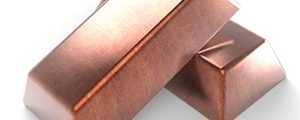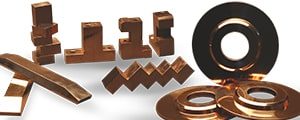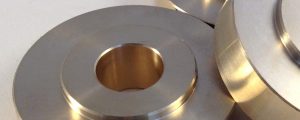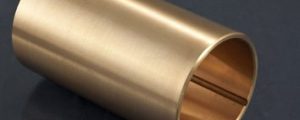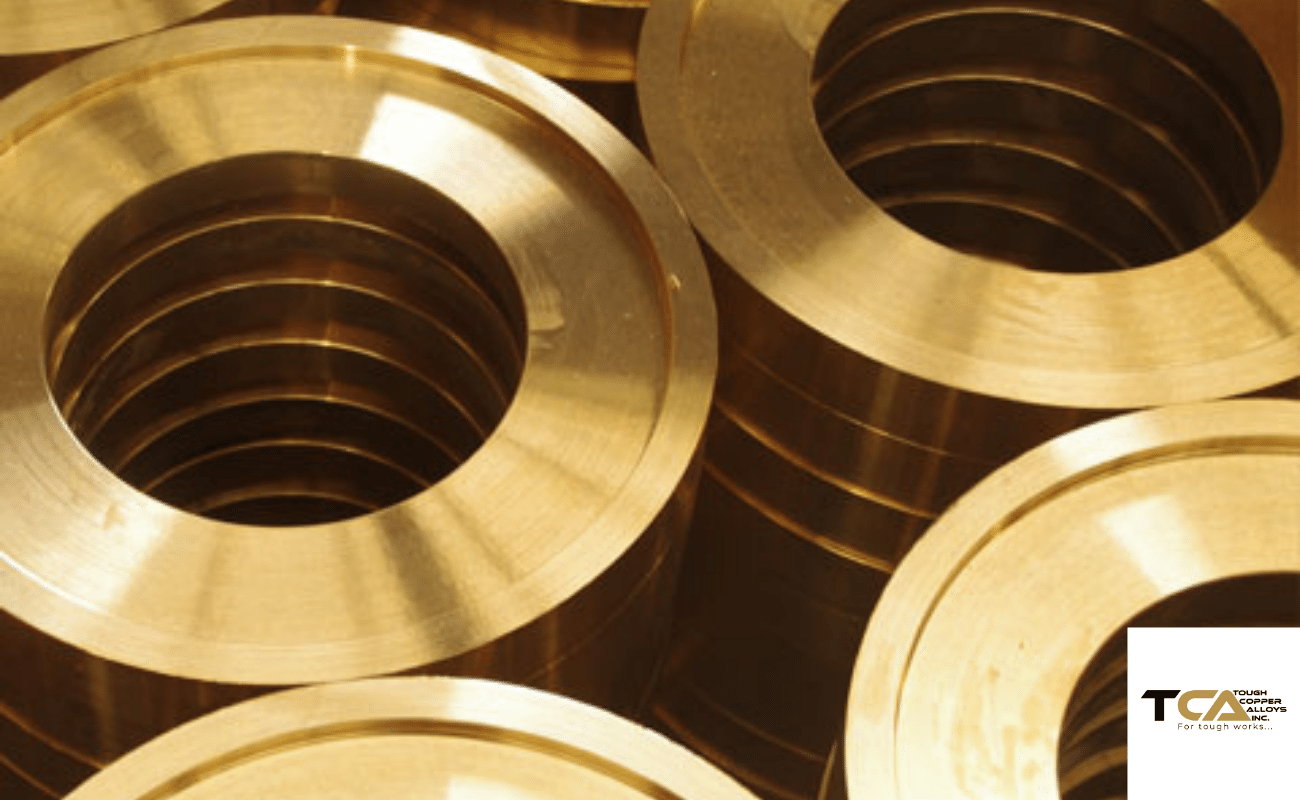What is “C64210” Material?
C64210 is a copper-nickel-tin alloy that is commonly referred to as aluminum bronze. It is a popular choice for applications that require high strength, corrosion resistance, and wear resistance. C64210 is a member of the wrought copper alloy family, which means it is made by shaping and forming the material through mechanical processes rather than by casting.
The primary alloying elements in C64210 are copper, nickel, and tin. Copper is the main component, typically making up over 80% of the alloy by weight. Nickel provides additional strength and corrosion resistance, while tin improves the alloy’s wear resistance and helps to prevent dezincification.
One of the key advantages of C64210 is its excellent resistance to corrosion, particularly in marine environments where seawater can cause significant damage to metal components. This makes it a popular choice for marine hardware, including propellers, bearings, and other components that are exposed to seawater.
In addition to its corrosion resistance, C64210 also offers high strength and wear resistance, making it suitable for use in heavy-duty applications. It has a tensile strength of around 105 ksi (725 MPa) and a yield strength of around 45 ksi (310 MPa), as well as good ductility and impact resistance.
C64210 is available in a range of forms, including bars, tubes, and sheets, making it suitable for a wide range of manufacturing processes. It can be easily machined, welded, and brazed, allowing it to be used in a variety of applications across different industries.
Overall, C64210 is a versatile and reliable material that offers a range of benefits for manufacturers and end-users alike. Its high strength, corrosion resistance, and wear resistance make it an ideal choice for a wide range of applications, particularly those that require durability and longevity in harsh environments.
Application Areas & Industries
C64210, also known as aluminum bronze, is a versatile material that finds application in a variety of industries due to its unique combination of mechanical and physical properties. Here are some of the application areas and industries where C64210 is commonly used:
- Marine: C64210’s excellent corrosion resistance and durability make it ideal for marine applications such as propellers, pumps, valves, and ship fittings.
- Aerospace: Due to its high strength and resistance to wear and corrosion, C64210 is frequently used in the aerospace industry for components such as bushings, bearings, and gears.
- Oil and Gas: C64210’s resistance to corrosion and wear make it a popular choice for oil and gas industry applications such as valves, pumps, and pipe fittings.
- Automotive: C64210 is used in the automotive industry for components such as bearings, gears, and valve guides due to its high strength and wear resistance.
- Construction: The high strength, durability, and resistance to corrosion of C64210 make it suitable for use in construction applications such as bridge bearings and hydraulic structures.
- Electrical: C64210’s excellent electrical conductivity and resistance to corrosion make it ideal for electrical connectors, terminals, and switch parts.
- Manufacturing: C64210 is also used in manufacturing applications such as welding rods and forging dies due to its high strength and resistance to wear.
Overall, C64210’s unique combination of properties makes it a versatile material that can be used in a wide range of applications and industries. Its exceptional corrosion resistance and durability make it particularly well-suited for harsh environments, while its high strength and wear resistance make it suitable for high-stress applications.
Common Fabrication Processes
C64210 is a copper-nickel-tin alloy with excellent corrosion resistance and high strength, making it an ideal material for use in various industrial applications. To maximize the benefits of C64210, it is crucial to use the right fabrication processes during production.
Here are some of the most common fabrication processes used for C64210:
- Machining: Machining is a process that involves cutting or shaping a material using various tools such as lathes, milling machines, and drill presses. C64210 is machinable and can be easily shaped into different parts and components.
- Welding: Welding is a process that involves joining two or more materials by heating them to a high temperature and applying pressure to fuse them together. C64210 can be welded using various techniques such as gas tungsten arc welding (GTAW), gas metal arc welding (GMAW), and resistance welding.
- Brazing: Brazing is a process that involves joining two or more materials by heating them to a temperature below their melting point and applying a filler metal that melts and flows to form a bond. C64210 can be brazed using various techniques such as torch brazing, furnace brazing, and induction brazing.
- Hot forging: Hot forging is a process that involves heating the material to a high temperature and then shaping it using a forging press. C64210 can be hot forged into different shapes and sizes.
- Cold working: Cold working is a process that involves shaping a material at room temperature by rolling, bending, or drawing it through a die. C64210 can be cold worked to improve its strength and hardness.
By using the right fabrication processes, manufacturers can ensure that C64210 performs optimally in various industrial applications. It is essential to consult with a materials expert or supplier to determine the best fabrication processes for specific C64210 applications.
Chemical Composition
C64210 is a copper-nickel-tin alloy that is known for its excellent corrosion resistance, particularly in marine environments. The chemical composition of C64210 typically includes copper (Cu), nickel (Ni), tin (Sn), and sometimes small amounts of other elements like iron (Fe) and manganese (Mn).
The exact composition of C64210 can vary depending on the specific manufacturing process, but typically falls within the following ranges:
- Copper: 72-75%
- Nickel: 22-25%
- Tin: 0.5-1.5%
- Iron: 0.1-0.25%
- Manganese: 0.1-0.25%
These elements work together to provide C64210 with its unique properties, including excellent resistance to corrosion, high strength, and good machinability. The high nickel content in particular helps to provide resistance to both saltwater and freshwater corrosion, making it a popular choice for marine applications.
It is important to note that the exact chemical composition of C64210 may vary depending on the specific application and manufacturing process. Consulting with a materials expert or supplier can help ensure that the appropriate alloy is selected for a particular use.
| Element | Composition (%) |
|---|---|
| Copper (Cu) | 95.0 – 97.0 |
| Aluminum (Al) | 2.0 – 4.0 |
| Nickel (Ni) | 0.60 – 1.50 |
| Iron (Fe) | 0.20 – 0.60 |
| Manganese (Mn) | 0.05 max |
| Silicon (Si) | 0.05 max |
| Zinc (Zn) | 0.05 max |
| Lead (Pb) | 0.05 max |
| Arsenic (As) | 0.05 max |
| Phosphorus (P) | 0.02 max |
Note that the values provided are approximate and may vary depending on the specific composition and processing of the C64210 material.
Physical Properties
C64210 is a copper-nickel-tin alloy that is highly valued for its excellent resistance to corrosion and erosion. Its physical properties are essential to consider when selecting it for specific applications. Here are some of the key physical properties of C64210:
Density: C64210 has a density of 0.321 lb/in³ (8.90 g/cm³), which is slightly higher than that of pure copper. This property contributes to its excellent mechanical properties, including high strength and hardness.
Melting Range: The melting range of C64210 is between 1880-1920°F (1027-1049°C), which is relatively high. This makes it suitable for high-temperature applications, such as heat exchangers and furnace parts.
Thermal Conductivity: C64210 has a high thermal conductivity of 41 Btu-in/ft²-hr-°F (5.92 W/m-K), which makes it an excellent choice for heat transfer applications. Its high thermal conductivity ensures efficient heat transfer and dissipation.
Electrical Conductivity: C64210 has a moderate electrical conductivity of 8% IACS (International Annealed Copper Standard). Its electrical conductivity makes it a preferred material for electrical connectors and other electrical components.
Coefficient of Thermal Expansion: The coefficient of thermal expansion of C64210 is 9.5×10^-6 in/in-°F (17.1 μm/m-°C), which is lower than many other copper alloys. This property makes it more dimensionally stable under temperature fluctuations.
Modulus of Elasticity: C64210 has a modulus of elasticity of 19,000 ksi (131 GPa), which is relatively low compared to some other copper alloys. This property contributes to its high ductility and ability to be easily formed into different shapes.
Overall, the physical properties of C64210 make it a versatile material that can be used in various applications, including marine components, heat exchangers, and electrical connectors. Its excellent resistance to corrosion and erosion also makes it a preferred material in harsh environments. If you need more information about the physical properties of C64210 or have any other questions, please feel free to contact us.
Fabrication Properties
C64210 is a copper-nickel-tin alloy that is widely used in various industries due to its excellent corrosion resistance and high thermal conductivity. This material can be easily fabricated using various techniques, making it a versatile option for different applications. Here are some of the most common fabrication properties of C64210:
Hot Forging: C64210 can be readily hot forged into different shapes, including bars, plates, and rods. The process involves heating the alloy to a high temperature and then shaping it using mechanical force.
Cold Working: Cold working is another popular method for shaping C64210. This process involves shaping the alloy at room temperature or below to increase its strength and hardness. Techniques such as rolling, bending, and drawing can be used to create different shapes and sizes.
Machining: C64210 can be machined using conventional methods such as turning, drilling, and milling. However, the material has a high tendency to work harden, which can affect the machining process. Therefore, appropriate cutting tools and machining parameters should be used to minimize the work hardening effect.
Welding: C64210 can be welded using various techniques, including gas tungsten arc welding (GTAW), gas metal arc welding (GMAW), and resistance welding. However, the welding process should be carefully controlled to avoid overheating or distortion due to C64210’s low melting point compared to other copper alloys.
Overall, the fabrication properties of C64210 make it a versatile material that can be easily formed into different shapes using various fabrication processes. Its excellent corrosion resistance and high thermal conductivity make it an ideal choice for applications in the marine, aerospace, and electrical industries. If you need more information about the fabrication properties of C64210 or have any other questions, please feel free to contact us.
Applicable Specifications of “C64210”
C64210 is a copper-nickel-tin alloy that boasts excellent corrosion resistance and high thermal conductivity. To ensure that C64210 meets the required standards and specifications for different applications, several organizations have established applicable specifications for this material.
These specifications include:
ASTM B122/B122M: This specification covers copper-nickel-tin alloy plates, including C64210. It outlines the chemical composition, mechanical properties, and other requirements for the material.
ASTM B151/B151M: This specification covers copper-nickel-tin alloy rods and bars, including C64210. It outlines the chemical composition, mechanical properties, and other requirements for the material.
ASTM B171/B171M: This specification covers copper-alloy plate, sheet, strip, and rolled bar, including C64210. It outlines the chemical composition, mechanical properties, and other requirements for the material.
SAE J461: This specification covers copper-nickel-tin alloys, including C64210, in the form of bars, rods, wires, and forgings. It outlines the chemical composition, mechanical properties, and other requirements for the material.
SAE J463: This specification covers copper alloys, including C64210, in the form of plates, sheets, strips, and bars. It outlines the chemical composition, mechanical properties, and other requirements for the material.
ISO 1338: This standard specifies the chemical composition and mechanical properties of copper-nickel-tin alloys, including C64210.
It’s essential to note that different applications may require specific specifications and standards for C64210. For example, the marine industry may require compliance with the specifications established by organizations such as the American Bureau of Shipping (ABS) or the International Maritime Organization (IMO).
In conclusion, C64210 is a copper-nickel-tin alloy that is subject to various applicable specifications and standards, including ASTM B122/B122M, ASTM B151/B151M, ASTM B171/B171M, SAE J461, SAE J463, and ISO 1338. Compliance with these specifications is essential to ensure that C64210 meets the required standards for specific applications. If you need more information about the applicable specifications of C64210 or have any other questions, please feel free to contact us.
Thermal Properties
C64210 is a copper-nickel-tin alloy with exceptional thermal properties that make it suitable for a wide range of applications. Here are some of the thermal properties of C64210:
Thermal Conductivity: C64210 has a high thermal conductivity, which means it can transfer heat quickly and efficiently. The thermal conductivity of C64210 is typically in the range of 38-56 W/m·K, which is higher than that of pure copper.
Thermal Expansion: C64210 has a low coefficient of thermal expansion, meaning that it expands and contracts less than other materials when exposed to temperature changes. The coefficient of thermal expansion for C64210 is typically in the range of 13.7-14.6 µm/m·K.
Melting Point: C64210 has a relatively high melting point compared to other copper alloys. The melting point of C64210 is typically in the range of 1085-1215°C, depending on the specific composition of the alloy.
Specific Heat: C64210 has a relatively high specific heat capacity, meaning it can absorb a significant amount of heat without a significant increase in temperature. The specific heat of C64210 is typically in the range of 377-385 J/kg·K.
Thermal Fatigue Resistance: C64210 exhibits excellent resistance to thermal fatigue, making it suitable for high-durability applications under extreme thermal conditions.
In conclusion, C64210 is a copper-nickel-tin alloy with exceptional thermal properties, including high thermal conductivity, low coefficient of thermal expansion, high melting point, high specific heat capacity, and excellent resistance to thermal fatigue. These properties make it suitable for various applications that require efficient heat transfer, stability over a wide temperature range, and high durability under extreme thermal conditions. If you need more information about the thermal properties of C64210 or have any other questions, please feel free to contact us.
Typical Uses
C64210, a copper-nickel-tin alloy, is a versatile material with exceptional thermal properties, making it suitable for a wide range of applications across various industries. Here are some of the typical uses of C64210:
- Marine Applications: C64210 is a popular material in marine applications due to its excellent resistance to seawater corrosion and biofouling. It is commonly used in heat exchangers, condensers, and piping systems in boats, ships, and other marine vessels.
- Aerospace Applications: The high durability and resistance to thermal fatigue of C64210 make it an ideal material for aerospace components such as heat exchangers, landing gears, and hydraulic systems.
- Electrical Contacts: C64210 is also widely used in electrical contacts due to its high electrical conductivity and resistance to wear and corrosion. It is commonly used in switches, relays, and connectors in various electronic devices.
- Industrial Applications: C64210’s excellent thermal conductivity and low thermal expansion coefficient make it an ideal material for heat exchangers, valves, and pumps used in industrial applications.
- Medical Applications: C64210 is a biocompatible material and is commonly used in medical applications such as surgical instruments and implants.
- Automotive Applications: C64210’s high thermal conductivity and low thermal expansion coefficient make it suitable for automotive applications such as radiators, heat exchangers, and brake systems.
In summary, C64210 is a versatile copper-nickel-tin alloy with exceptional thermal properties that make it suitable for a wide range of applications across various industries. Its typical uses include marine, aerospace, electrical contacts, industrial, medical, and automotive applications. If you need more information about the typical uses of C64210 or have any other questions, please feel free to contact us.
Equivalents of “C64210”
C64210 is a copper-nickel-tin alloy known for its exceptional thermal properties, making it a popular choice for various applications. However, there may be instances where C64210 is not readily available or suitable for a specific application. In such cases, it is essential to consider the equivalents of C64210, which are other copper alloys with similar properties. Here are some of the common equivalents of C64210:
C70600: C70600, also known as copper nickel 90/10, is an alloy that contains 90% copper and 10% nickel, making it an excellent substitute for C64210 in many applications. C70600 has a similar thermal conductivity and resistance to thermal fatigue, making it an ideal replacement for C64210 in marine and offshore applications.
C71500: C71500, also known as copper nickel 70/30, is an alloy that contains 70% copper and 30% nickel, making it an excellent substitute for C64210 in applications where higher resistance to corrosion is required. C71500 has similar thermal properties to C64210, making it suitable for heat exchangers, condensers, and other applications that require efficient heat transfer.
C44300: C44300, also known as admiralty brass, is a copper-zinc alloy with small amounts of impurities such as iron, arsenic, and lead. C44300 has a high thermal conductivity and excellent resistance to corrosion, making it an excellent replacement for C64210 in marine and offshore applications.
Overall, while C64210 is a unique copper-nickel-tin alloy with exceptional thermal properties, there are several equivalents available that can be used as substitutes for C64210 in various applications. It is essential to consult with a materials engineer or supplier to determine the most suitable equivalent for a specific application.
Mechanical Properties
C64210 is a copper-nickel-tin alloy with remarkable mechanical properties that make it a preferred material for many industrial applications. Here are the key mechanical properties of C64210:
Tensile strength: C64210 exhibits a high tensile strength, comparable to that of steel, making it ideal for applications that require high mechanical resistance.
Fatigue resistance: With excellent fatigue resistance, C64210 is perfect for applications subjected to repeated cycles of stress, such as springs, fasteners, and other components that undergo cyclic loading.
Machinability: C64210 has excellent machinability, making it a popular choice for various components in the aerospace and defense industries. It can be easily machined into complex shapes, which is crucial in applications requiring intricate and precise machining.
Thermal conductivity: C64210 has exceptional thermal conductivity, making it an excellent material for heat exchangers and other applications that require efficient heat transfer.
Overall, C64210 is a reliable material for heavy-duty equipment, automotive parts, marine components, and other industrial applications. If you need more information on the mechanical properties of C64210 or assistance in selecting the right material for your application, please feel free to contact us.
Please note that the mechanical properties of C64210 may vary depending on the specific production process and testing method used. Therefore, it’s important to refer to appropriate standards and specifications for detailed information on the mechanical properties of C64210.
| PROPERTY | VALUE |
|---|---|
| Tensile Strength | 515 MPa (75,000 psi) |
| Yield Strength | 240 MPa (35,000 psi) |
| Elongation at Break | 18% |
| Hardness, Brinell | 165 |
| Hardness, Rockwell B | 85 |
| Modulus of Elasticity | 105 GPa (15,200 ksi) |
Please note that the mechanical properties of C64210 may vary depending on the specific production process and testing method used. Therefore, it’s important to refer to appropriate standards and specifications for detailed information on the mechanical properties of C64210.

